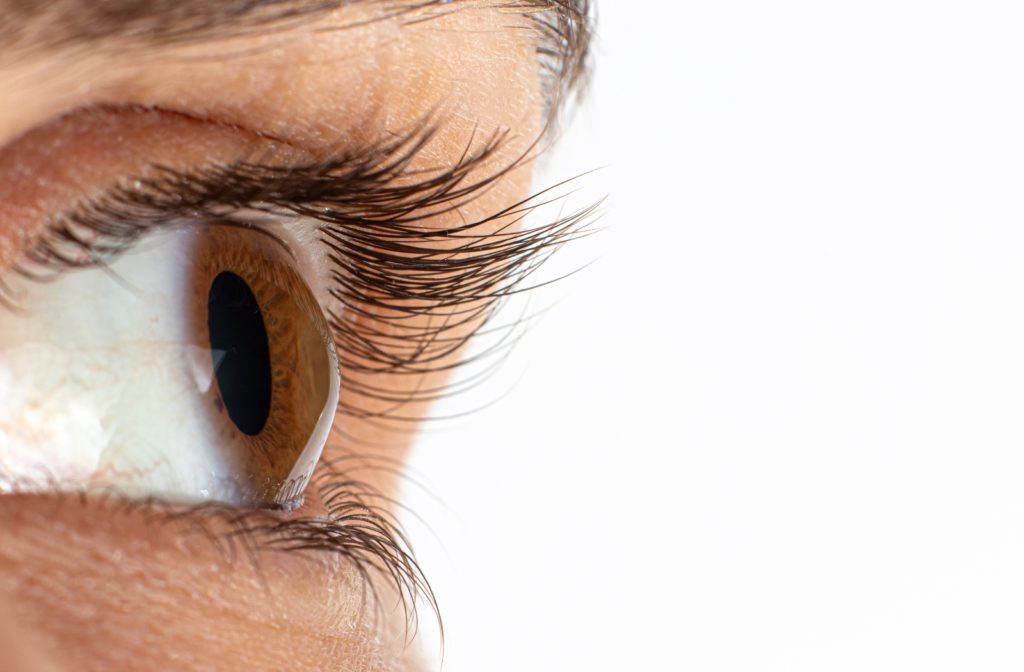Diagnosing Keratoconus
Many eye conditions and eye diseases can progress slowly, so many people don’t notice symptoms immediately. It’s crucial to see your optometrist regularly to protect your eye health and detect eye disorders like keratoconus.
Regular comprehensive eye exams can help you and your optometrist keep a closer eye on changes to your eyes. The better we understand your eye health and any changes, the better we can prevent an eye emergency or vision loss.
For patients with keratoconus, understanding the causes or risks can prevent the condition from progressing or developing harmful symptoms.
What Is Keratoconus?
Keratoconus is a vision disorder affecting the quality and shape of the cornea, preventing light from entering the eye. The cornea is ordinarily dome-shaped, but keratoconus causes the tissue to thin and bulge outward like a cone.
When the irregular cornea cannot refract light, our vision quality is diminished. The eye condition can have similar vision impacts as refractive errors (also resulting from an irregular eye shape).
Minor vision changes caused by keratoconus can be corrected with prescription eyeglasses or contact lenses. However, keratoconus is a progressive condition, and vision can worsen with time. Regular eye exams can help assess vision changes and provide more up-to-date prescriptions.
Keratoconus is usually a bilateral condition (affecting both eyes), but each eye can develop with some variation.
Symptoms of Keratoconus
The most common symptoms of keratoconus are:
- Blurry near & far vision
- Halos around lights
- Light streaks
- Triple or double vision
- Blurry vision when driving
Although less common, keratoconus can develop a tiny crack in the cornea due to swelling. The swelling can suddenly and significantly distort vision. However, the crack eventually heals, forming scar tissue and resolving the increased swelling.
Keratoconus can progressively worsen, typically for 10–20 years. Then, the condition tends to
slow or stabilize.
The Genetics of Keratoconus
Research about keratoconus causes is still inconclusive about whether genetics play a significant role. However, 1 in 10 patients with keratoconus has a close relative with the eye disorder.
Studies attempting to understand the genetic causes of keratoconus typically focus on collagen structure. Collagen is a protein found in connective tissues and is responsible for:
- Tissue repair
- Immune response
- Cellular communication
- Cellular migration
Our bodies naturally make collagen. But when we experience collagen deficiencies, it can impact eye health, particularly the cornea and sclera.
Other Causes of Keratoconus
In addition to shared family history, environmental factors and health conditions are linked to keratoconus. Other risk factors for keratoconus include:
- Allergies
- Asthma
- Down’s syndrome
- Retinitis pigmentosa
- Ehlers-Danlos syndrome (EDS)
- Frequent eye rubbing
Eye Rubbing
Aggressive eye rubbing weakens tissues with repeated corneal trauma. Knuckle rubbing, which uses the hardest parts of your hands, can be particularly abrasive.
Allergies
Allergies can cause eyes to feel irritated and itchy, which increases how often you rub your eyes. Eye allergies can also cause:
- Inflammation
- Watery eyes
- Light sensitivity
- Burning sensation
Asthma
Some research suggests medications for asthma may affect the cornea. Asthma can also cause inflammation, which may also impact corneal health. However, the link between asthma and keratoconus is still under review. There are too few studies to draw conclusive evidence.
Contact Lenses
Contact lens wearers touch their eyes more frequently. If the contact irritates the eye, it can lead to eye rubbing. Additionally, wearing contacts increases the risk of cornea damage, such as corneal ulcers or scratches.
Sun Exposure
UV radiation can damage our eyes, including the cornea. Notably, sun damage over time can weaken frontal eye tissue, making our eyes vulnerable to wearing thin.
Sleep Apnea
There is also a link between patients with sleep apnea and keratoconus, as both tend to rub their eyes more frequently. When floppy eyelid syndrome (FES) occurs alongside sleep problems, the strong correlation usually indicates patients should visit their optometrist for an eye exam.
Managing Keratoconus
Although there is no cure for keratoconus, there are ways to manage and treat symptoms of the condition. Some options include:
- Contact lenses
- Corneal cross-linking
- Penetrating keratoplasty (corneal transplant)
- Deep anterior lamellar keratoplasty (DALK)
Keratoconus can affect individuals differently. Different levels of progression impact visual ability and eye health uniquely. Your optometrist will recommend a customized approach best for your comfort and eye health.
Contact Us for Supportive Eye Health
Understanding the overlapping causes of eye conditions and diseases can be challenging, as many have genetic and environmental factors. Although there’s much more we can learn about the background of keratoconus, many treatments and management options are available.
If you’re experiencing vision symptoms, visit us at the Perspective Eye Center. We can assess your eye health and recommend a personalized plan of action. Contact us for an appointment today!



